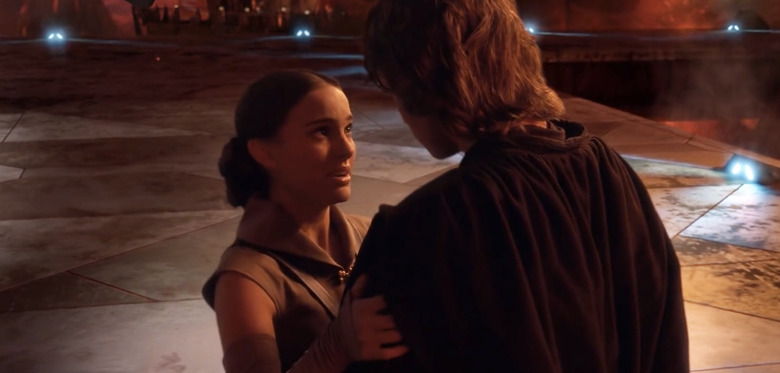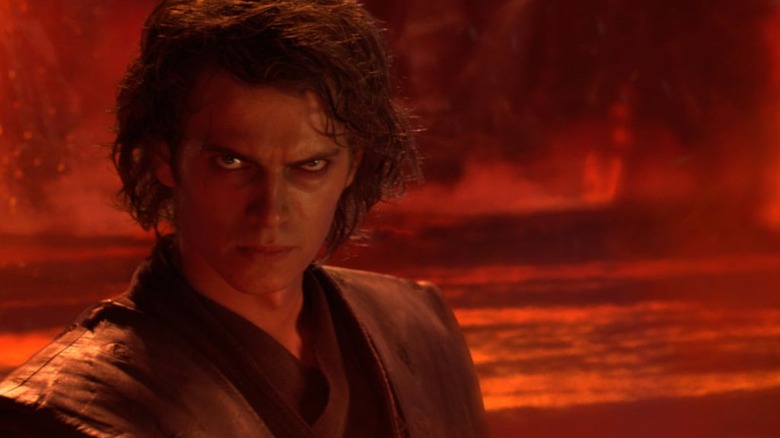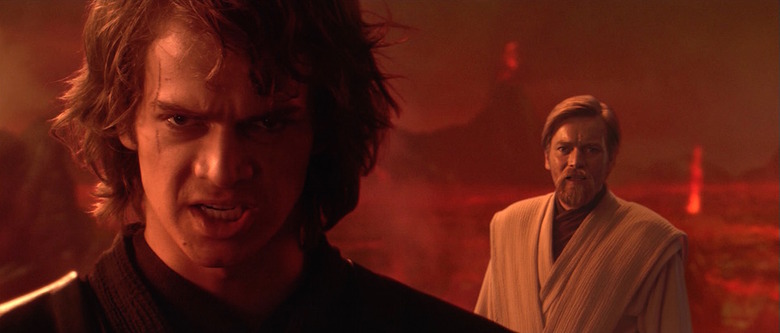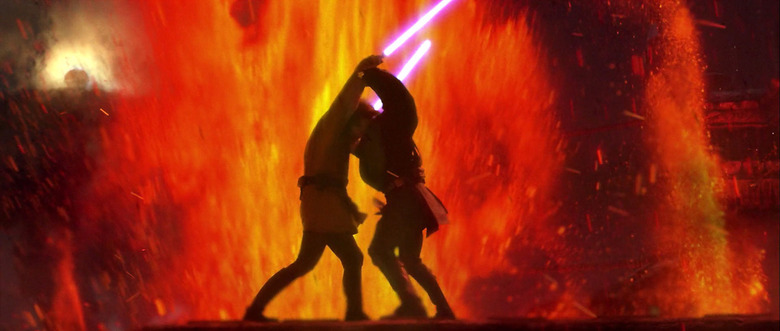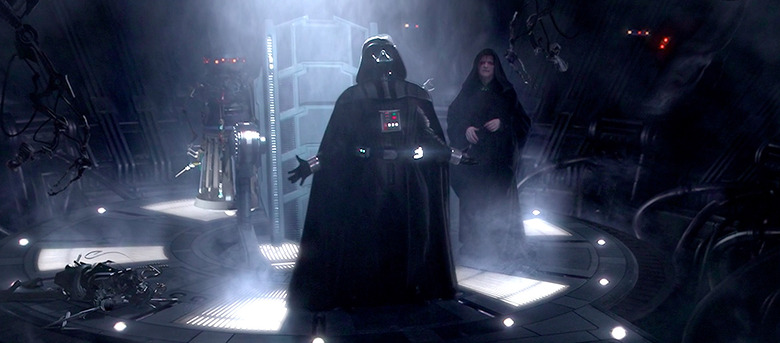The Novelization Of 'Revenge Of The Sith' Is One Of The All-Time Best 'Star Wars' Stories
When you think of Star Wars, you think of the movies first and foremost. Sure, Star Wars Rebels ranks among the Star Wars stories, and the Extended Universe books are beloved by all who suffered through the Dark Age in the '80s and early '90s, a time before we were blessed with new content every three minutes or so. But for the most part, Star Wars fandom begins and ends with the movies.I'm a prequels kid (see also: Millennial), in that the prequel trilogy was the one that truly ensnared my imagination and drew me into the fandom. (Sorry not sorry, don't let the door hit you on the way out.) And before The Force Awakens graced our screens, I used to consistently and emphatically rank Revenge of the Sith as my favorite Star Wars film (while editing out the mistreatment of Padmé Amidala in my head, of course). But I was always fudging my answer a little. Because it wasn't the Revenge of the Sith movie I loved so deeply – it was the book.
A Brief History of Novelizations
Novelizations have long been a part of Hollywood history. According to an article in Vanity Fair, the concept of adapting movies into books emerged all the way back in the silent film era, and became understandably popular before the propagation of home video made possible an infinite number of re-viewings. Nowadays, novelization writing can sometimes be a thankless and grueling job – last-minute script alterations and persnickety studio demands can wreak havoc on an author's writing schedule and psyche – but it also offers the opportunity for fans and creators alike to dive deeper into mythology, character development, and scenes that didn't make the final cut of the film. (Are deleted scenes considered canon? Discuss.)In this age of content inundation, the recent release of the novelization of The Last Jedi has served as yet another source of Star Wars-related information that the fandom immediately began to suck dry. Jason Fry's rendition of Rian Johnson's film is indeed a fine addition to the collection of Star Wars novelizations (as General Grievous might say), if a bit Disney-fied. And yet...Perhaps I've become a bit jaded, but it feels as though this novelization was produced mostly to cater to fans and reporters who sped through the book as soon as it hit the presses just to be the first to post a clickbait tweet about an extended sequence, a missing line, or a small detail about a "new" Force power. Reading the novelization for The Last Jedi made me nostalgic for the novelization of a significantly less lauded Star Wars film, Revenge of the Sith, and all of the ways that author Matthew Stover expanded on the epic Star Wars mythos and the larger-than-life heroes in a unique, ceaselessly engaging, and emotionally fraught tale of love and loss.
Writing Style
"The end starts now."The four words that complete the book's epigraph are weighted with import and gravitas, somberly setting the tone for the unavoidable tragedy that is to come. The prequel trilogy as a whole charts the rise and fall of Anakin Skywalker and of the esteemed Jedi Order, so the bulk of the "fall" takes place during the events of Episode III. As such, Revenge of the Sith really is a tragedy in the truest sense, an embrace of the tropes promulgated and perfected by ancient Greek playwrights: there is prophecy, there is hubris, and there is brutal inevitability.Indeed, the inevitability is compounded by the fact that readers of the Revenge of the Sith novelization (and novelizations in general) already know the story because they've already seen the movie. Which means that the style of writing – the way the story is told – is perhaps even more critical to the enjoyment of a novelization than to the enjoyment of a regular ol' novel. You don't read the Revenge of the Sith novelization to be shocked by the plot twists (Anakin Skywalker becomes who?!) but to be moved by the written language, and to envelop yourself in the inner monologues of characters whose actors (ahem) may not have reflected such depth on the screen.Stover's novelization contains an epigraph before each of the book's four sections, and these brief but magnificent passages wax poetic about the darkness and the light in a way that illuminates the saga as a whole, befitting the grandiosity of the space opera genre. Behold:"The dark is generous, and it is patient, and it always wins – but in the heart of its strength lies weakness: one lone candle is enough to hold it back.Love is more than a candle.Love can ignite the stars."
War Becomes Art
The story of Revenge of the Sith stands at the apex of "The Age of Heroes" and tips over into its nadir, and Stover's writing style – and once personal, visceral, and internal, but also epic, sweeping, and spirited – beautifully embodies the tale's intensity. The film version of Revenge of the Sith marked the Star Wars saga's first PG-13 rating, and the novelization feels more adult as well – or at least more literary. Even the lightsaber battles spark to life on the page, thanks to a combination of Stover's real-life martial arts experience and his impressive (most impressive) knowledge of lightsaber lore.Consider the scintillating tableau of poetry in motion evoked by the opening act fight between Anakin, Obi-Wan, and Count Dooku. Told from Dooku's point of view, the beginning of the duel seems to lean in Dooku's favor: "It was a simple matter of countering their tactics, which were depressingly straightforward; Skywalker was the swift one, whooshing here and there like a spastic hawk-bat... while Kenobi came on in a measured Shii-Cho cadence, deliberate as a lumberdroid, moving step by step, cutting off the angles, clumsy but relentlessly dogged..." (Note, too, the word choices – does it even matter what a "spastic hawk-bat" actually looks like? Nope, because my brain is already buzzing That's good writing.)Later on, though, the battle tilts: "Skywalker came on, mechanically inexorable, impossibly powerful, a destroyer droid with a lightsaber: each step a blow and each blow a step....Skywalker's Shien ready-stance had been a ruse, as had his Ataro gymnastics; the boy was a Djem So stylist, and as fine a one as Dooku had ever seen."Sure, the lightsaber battles may look really cool on the screen – but on the page, Stover turns each fight into a stunning and intricate ballet. At Stover's fingertips, war becomes art.
Character Insights
One benefit of point-of-view storytelling is that we get to see truth as a matter of perspective. Yes, Anakin completely goes off the deep end in Revenge of the Sith, but we get to witness his descent into darkness through his own eyes – we get to experience more of Palpatine's conversations with Anakin, and we see precisely how the Chancellor's honey-tinted words get twisted around in Anakin's damaged psyche. We even get an amusing glimpse into Dooku's mind at the beginning of the novelization – Stover writes that Dooku is "terribly, terribly tempted to wink at Palpatine" when Anakin declares that Sidious is probably already in Jedi custody – that is, until Anakin relieves him of his head, of course.However, my favorite characterization in Matthew Stover's Revenge of the Sith is that of Obi-Wan Kenobi. You probably already have an image in your head of the great Jedi Master as a paradigmatic Jedi: he is dignified and wise as the last of his kind in A New Hope, and he is fiercely respected as a top general of the Grand Army of the Republic in The Clone Wars. He is a member of the esteemed Jedi Council, and he is the the mentor or Master of two esteemed "Chosen Ones." Yet at the same time, it's sometimes hard to identify with him, and his motivations are more often than not utterly opaque. In The Clone Wars, Obi-Wan comes across as stuffy and stoic (or, more bluntly, as a total dick), and he's pretty deceitful in the original trilogy as well. He's kind of the worst.But Stover brilliantly manages to humazine Obi-Wan and build him up as "the ultimate Jedi." He does this by acknowledging the great General Kenobi's reputation – and then completely dismantling it inside Obi-Wan's mind. Behold:"This is Obi-Wan Kenobi:A phenomenal pilot who doesn't like to fly. A devastating warrior who'd rather not fight. A negotiator without peer who frankly prefers to sit alone in a quiet cave and meditate.Jedi Master. General in the Grand Army of the Republic. Member of the Jedi Council. And yet, inside, he feels like he's none of these things.Inside, he still feels like a Padawan."In one fell swoop, Stover gives the character of Obi-Wan Kenobi something he has been missing for decades: vulnerability. We see this play out over the course of the novelization as well. There's the scene where he walks away from Padmé after confronting her about Anakin's turn to the Dark Side and she observes: "He looked very alone." And when Obi-Wan appears during Padmé's own confrontation with Anakin on Mustafar and begs her to move away from him, she picks up on "an urgency in Obi-Wan's voice that sounded closer to fear than Padmé had ever heard from him." There's Obi-Wan's reaction to watching Anakin – his Padawan, his brother, his best friend – indiscriminately slaughter younglings on the Jedi Temple security footage.In the movie, Ewan McGregor merely mutters, "It can't be!" with a slight waver in his voice, but the novelization paints a more realistic and more gut-wrenching picture: "His head rang with a silent scream... He huddled against the console, blind with pain." He despondently tells Yoda he'd rather be dead, declaring that he should have let the Clones shoot him, that he should have perished along with Qui-Gon on Naboo. As he shuts down the video feed, he "wished that he had the strength to rip his eyes out of his head. But even blind, he would see this forever."Yeah, um, ouch.Through Obi-Wan, Anakin is given greater depth as well. In the novelization, Obi-Wan actually pushes back against the Council's decision to ask Anakin to spy on Palpatine, arguing that Anakin is "fiercely loyal" to his friends, and that Palpatine's friendship has meant so much to Anakin over the years. That loyalty is on full display when Anakin despairs of parting with Obi-Wan to go on separate missions (as it turns out, his anxiety is warranted; the scene proves to be the final goodbye between the two until they meet again as enemies on Mustafar) and Obi-Wan reassures Anakin and then praises him for his particular strengths. In an extension of the all-too-brief parting scene in the movie, Anakin laments his master's comment about the insignificance of "power," and Obi-Wan responds: "I am not speaking of your power, Anakin, but of your heart. The greatness in you is a greatness of spirit. Courage and generosity, compassion and commitment.... You have done great things, and I am very proud of you."These two, amiright? Amiright?! Well, now that you mention it...
The Team™
If the Revenge of the Sith novelization is known for one thing in particular among fans, it's the portrayal of the close relationship between Anakin Skywalker and Obi-Wan Kenobi. Shippers have an absolute field day with this book – and you've got to wonder if Stover is in on it as well, with lines like "they knew each other better than brothers, more intimately than lovers." YOUR WORDS, Stover! Your words!Romance aside (that's what fanfic is for, after all), the Kenobi-Skywalker friendship is important because it is the foundation of the true tragedy of Revenge of the Sith; it underlines the desperation of Anakin's Fall and highlights the magnitude of Obi-Wan's failure. Let's revisit the quote above for context – it comes from the moment Anakin and Obi-Wan ignite their sabers against each other, the beginning of the iconic "Battle of the Heroes," and the beginning of the end:"Blade-to-blade, they were identical. After thousands of hours in lightsaber sparring, they knew each other better than brothers, more intimately than lovers; they were complementary halves of a single warrior."In the movie, this sentiment is portrayed by an evocative image of the two Jedi locked in a desolate struggle, a moment reminiscent of the biblical struggle between Jacob and the angel.The agonized intensity of this duel comes across both on the screen and on the page, thanks to Lucas's poetic visuals and Stover's poetic language. The reason it cuts so deep is because of galactic and personal implications of the battle. The reason it hurts so much is because Stover does such a good job of building them up first – both as legends and as brothers.The introduction chapter of the novelization presents the unbeatable duo as mythological heroes; long before Broom Boy and his buddies began spreading the story of Luke Skywalker, Republic-era children told tales of two others: "Anakin and Obi-Wan. Kenobi and Skywalker," Stover writes. "From the beginning of the Clone Wars, the phrase Kenobi and Skywalker has become a single word.... Across the Republic – in words or pheromones, in magnetic pulses, tentacle-braids, or mental telepathy – the message from the younglings is the same: Don't worry. It'll be all right. Anakin and Obi-Wan will be there any minute." And though younglings may argue about who would win in a fight – the way our kiddos argue about a clash of two superheroes – they ultimately decide that it doesn't matter. Because "Anakin and Obi-Wan would never fight each other. They couldn't. They're a team. They're the team. And both of them are sure they always will be."I'll give you a moment to get those specks of dust out of your eye. Because the truth is, we never really see their intimacy in the prequels. Before Obi-Wan's anguished "You were my brother, Anakin! I loved you!" there was not much indication that any love existed between them at all. Stover's expansion on the film fixes that. Padmé, for one, knows that her husband and Obi-Wan are bound by the strength of brotherhood: she calls out Obi-Wan when he confronts her about Anakin ("You love him too, don't you?" she says), and when Anakin expresses doubts about Obi-Wan earlier on, Padmé insists: "Anakin, he's your best friend. He loves you."Unlike in the film, we see Anakin frantically search for a lifeline in Obi-Wan after Palpatine reveals himself to be a Sith Lord. We see Obi-Wan actually defend Anakin to Council leaders Yoda and Mace Windu, explaining Anakin's sense of loyalty: "He will stop at nothing to save me, for example, because he thinks I would do the same for him." A pause. "Because he knows I would do the same for him." And when Anakin and Obi-Wan finally face off, bringing with them the weight of all the pain and heartache they now wield against each other, Obi-Wan realizes: "The man he faced was everything Obi-Wan had devoted his life to destroying: Murderer. Traitor. Fallen Jedi. Lord of the Sith. And here, and now, despite it all... Obi-Wan still loved him."
Legacy
Though the Kenobi-Skywalker relationship holds a special place in my heart (and in the hearts of Tumblr gifset-makers the world over), there are other storytelling gems spread throughout the Revenge of the Sith novelization that also make it well worth the read. The shifting point-of-view style means we get to spend more time with noble Senator Bail Organa, and with wise Master Yoda. (Yoda's perspective is especially illuminating in parsing why exactly he abandoned his fight with Darth Sidious at the end.) Mace Windu also gets to enjoy the spotlight for a while, and Stover delves into Windu's unique Force-related ability to view "shatterpoints" quite a bit.So if you ever feel like rewatching some Star Wars movies, if you need to revisit the story of the "Age of Heroes" one more time – maybe, just maybe, try picking up the book instead.

